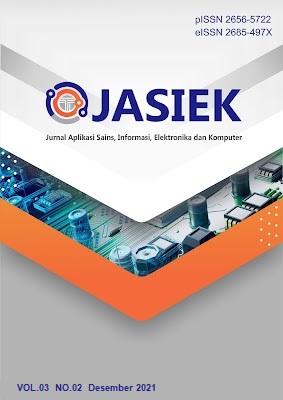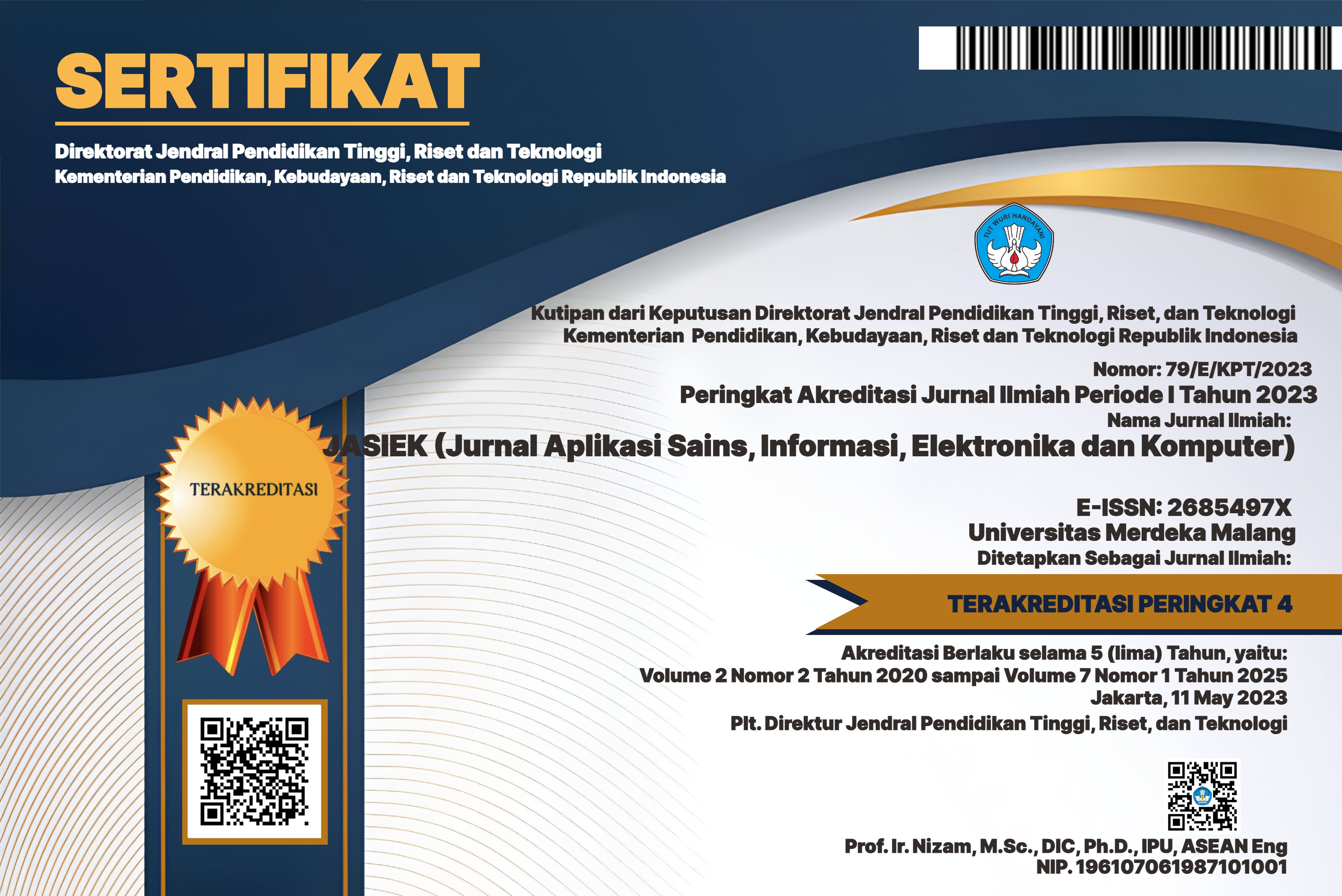Sistem Alat Pendeteksi Detak Jantung, Suhu Tubuh dan Tekanan Darah dengan Metode PID (Propotional Integral Derivative)
DOI:
https://doi.org/10.26905/jasiek.v3i2.8374Keywords:
Arduino Uno, Heart rate, Body Temperature, Pulse Sensor, DS18B20Abstract
One of the important things in military education are three main models, namely academic, behavioral attitude and physical training. Of the three main samples, the non-commissioned officer cadet is obliged to fulfill it. Such as physical training and related activities provided during basic education and skills courses. In this study, a system was made to determine heart rate, body temperature and blood pressure using the PID method. This research aims to make this a tool so that the health care team, when implementing physical activity health support, can quickly and practically help people, especially TNI soldiers. The results showed that PID control is suitable for this tool as it results in significant changes. The resulting response matches the characteristics of the PID controller. The error value between DS18B20 temperature sensor and digital thermometer is 0.22%, for armpit measurement, the error value between pulse sensor and oximeter is 0.6%. Meanwhile, the error value between the MPX5050DP probe and the digital sphygmomanometer is 1.4%.ÂDownloads
References
D. A. Prasetya and M. Ansori, “Implementasi Fuzzy Logic Pada Short Range Radar Untuk Pengamanan BT (Basis Tempur) Tingkat Regu,†J. Tek. Elektro dan Komput. TRIAC, vol. 5, no. 2, p. 4044, 2018.
H. Pujiyanto, G. E. Saputro, and A. Mansyah, “STRATEGI PEMBINAAN SATUAN YONARMED 13/2/1 KOSTRAD UNTUK MEWUJUDKAN PRAJURIT YANG PROFESIONAL GUNA MENDUKUNG TUGAS POKOK SATUAN,†Strateg. Pertahanan Darat, vol. 7, no. 2, 2021.
G. Grenaldo, “Hak Paten Untuk Memperoleh Pelayanan Kesehatan Di Rumah Sakit Di Tinjau Dari Hak Asasi Manusia,†J. Huk. Unsrat, vol. 2, no. 2, pp. 70–80, 2017.
A. B. Wijaya and A. S. KH, “Rancang bangun alatpengukur detak jantung dan suhu tubuh manusia berbasis komunikasi bluetooth,†EEPIS Final Proj., 2010.
Y. Afriansyah, R. Arifuddin, and Y. Novrianto, “Rancang Bangun Alat Pendeteksi Detak Jantung, Suhu Tubuh, dan Tensimeter Berbasis Arduino Uno serta Smartphone Android,†Pros. SinarFe7-IB, vol. 1, no. 2, 2018.
Yulidarti Hendri, “Rancang Bangun Alat Pengukur Detak Jantung Menggunakan Komunikasi Wifi dengan Android,†Issn 2302-3309, vol. 06, no. 01, pp. 277–285, 2020.
I. Prayogo, R. Alfita, and K. A. Wibisono, “Sistem Monitoring Denyut Jantung Dan Suhu Tubuh Sebagai Indikator Level Kesehatan Pasien Berbasis Iot (Internet Of Thing) Dengan Metode Fuzzy Logic Menggunakan Android,†J. Tek. Elektro dan Komput. TRIAC, vol. 4, no. 2, pp. 33–39, 2017.
R. L. Sidam, M. S. Suraatmadja, and H. Fauzi, “Perancangan Alat Ukur Denyut Nadi Menggunakan Sensor Strain Gauge Melalui Media Bluetooth Smartphone,†eProceedings Eng., vol. 3, no. 2, 2016.
Y. Kukus, W. Supit, and F. Lintong, “Suhu tubuh: homeostasis dan efek terhadap kinerja tubuh manusia,†J. Biomedik JBM, vol. 1, no. 2, 2009.
E. N. Indra, “Adaptasi fisiologis tubuh terhadap latihan di suhu lingkungan panas dan dingin,†in Proceeding Seminar Nasional PORPERTI UNY, 2007, vol. 18.
S. Hartini and P. P. Pertiwi, “Efektifitas kompres air hangat terhadap penurunan suhu tubuh anak demam usia 1-3 tahun di smc rs telogorejo semarang,†Karya Ilm., 2015.
P. Joenarto, “Sistem Pengukur Perubahan Tekanan Darah Menggunakan Oksimeter Foto Sebagai Komponen untuk Mendeteksi Stres pada Manusia,†J. Tek. dan Ilmu Komput., 2013
Downloads
Published
Issue
Section
License
Authors who publish with this journal agree to the following terms:
The journal allow the authors to hold the copyright without restrictions and allow the authors to retain publishing rights without restrictions.
Authors retain copyright and grant the journal right of first publication with the work simultaneously licensed under a Creative Commons Attribution-ShareAlike 4.0 International License that allows others to share the work with an acknowledgement of the work's authorship and initial publication in this journal.
Authors are able to enter into separate, additional contractual arrangements for the non-exclusive distribution of the journal's published version of the work (e.g., post it to an institutional repository or publish it in a book), with an acknowledgement of its initial publication in this journal.
Authors are permitted and encouraged to post their work online (e.g., in institutional repositories or on their website) prior to and during the submission process, as it can lead to productive exchanges, as well as earlier and greater citation of published work (See The Effect of Open Access).

This work is licensed under a Creative Commons Attribution-ShareAlike 4.0 International License.











